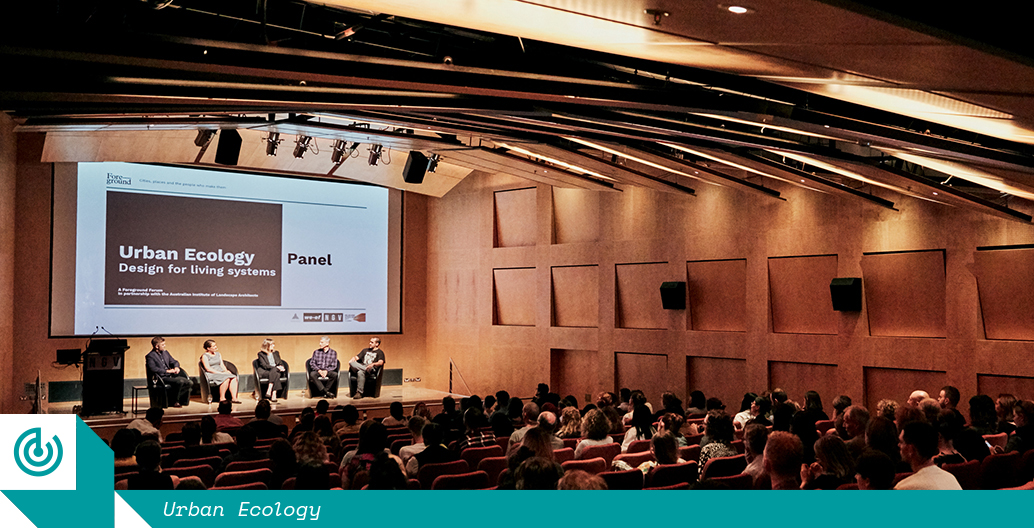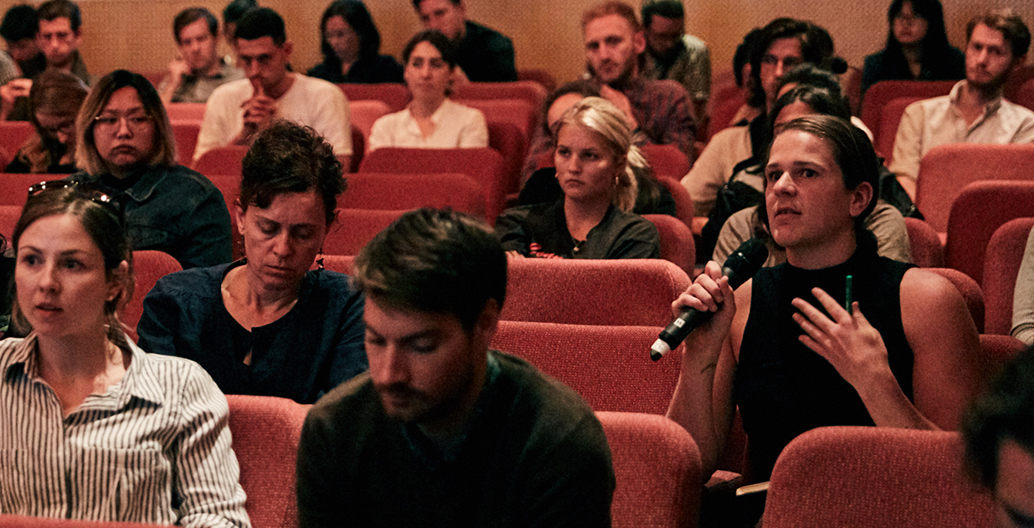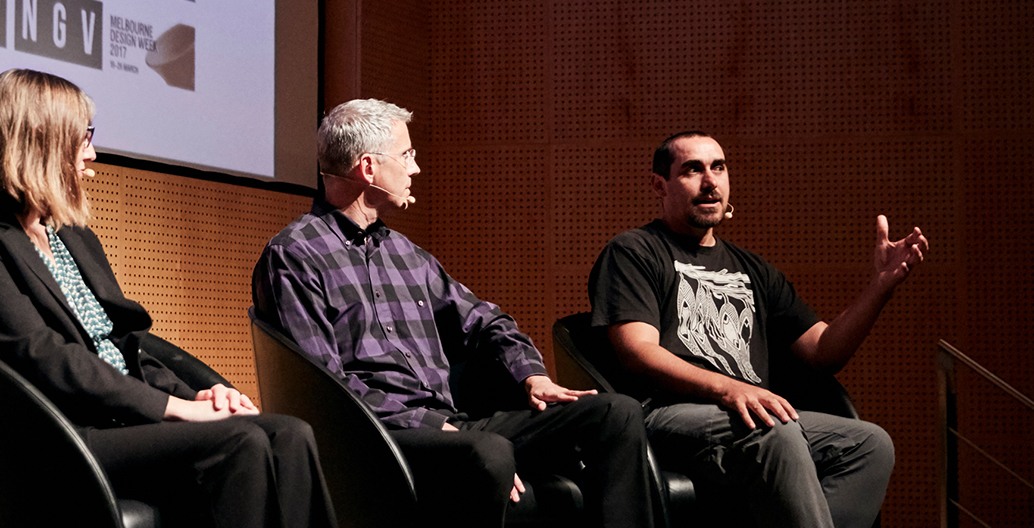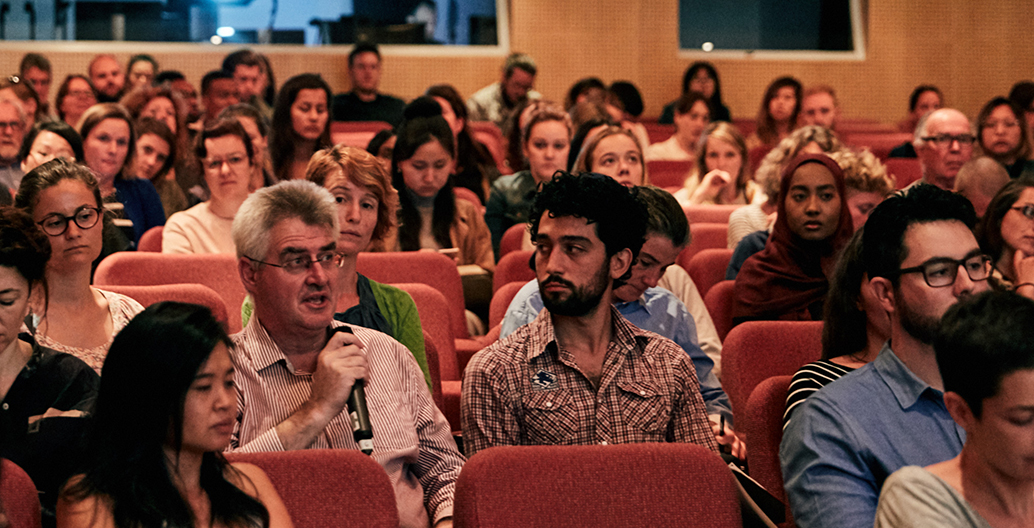
Urban ecology: Design for living systems (part 2/2)
Can we design our cities as living systems, in productive harmony with the environment? In part two of our transcript from the Melbourne Design Week 2017 forum on urban ecology, a planner, landscape architect urban ecologist, and Aboriginal architect discuss.
[This is second part of a two part transcript and recording from Foreground’s Urban Ecology forum. Click here to go the first part]
Maitiú Ward: Rueben, we touched on the Portrait building earlier [a.k.a. the Barak Building in Melbourne’s Swanston Street, which incorporates a giant portrait of Aboriginal leader William Barak]. From your perspective, does it have a value in defining the city as an Aboriginal place?
Rueben Berg: There’s definitely value in being able to see a visible presence of those sorts of elements. Those Aboriginal design elements help raise awareness. The Portrait building is always an example that people talk about in terms of an Aboriginal presence and it has its positives and it has its negatives as a project. But, generally speaking, the fact that I can walk down the street and look up and see a giant face of an Aboriginal man is a pretty powerful thing. And to also think that that came about not because someone legislated they should do it – that was their response to where they thought the market was at. 20 years ago, there is no way on earth a developer would have thought, “We want to sell more apartments, so what we’ll do is put a big Aboriginal face on it” – that’s crazy talk!
Maitiú Ward: So again Ron, marketing good or bad?
Ron Jones: I was going to ask Rueben: you don’t worry that the Portrait building was just because they used up all the other novelty graphic techniques?
Rueben Berg: It very well could be… the motivations behind things can vary. When I went to New Zealand to a conference of indigenous architects, we spoke about the presence we felt within our cities of a sense of aboriginality. They were talking about how we don’t have any presence, we can’t see any sense of an aboriginal element. And I was saying similar things, and then I thought, “Well, there is this giant building that has an Aboriginal face on it!” It is a powerful thing; it’s not necessarily perfect, but it is a very powerful thing to have that presence there. There is value in those sorts of gestures and they are not always going to be done perfectly right, but trying to do it and learning from the mistakes is better than not doing anything at all.

An audience member at the Urban Ecology forum poses a question to the panel.

Rueben Berg responding to an audience question at the Urban Ecology forum.

An audience member at the Urban Ecology forum poses a question to the panel.
Ron Jones: Marketing is something that designers, ecologists and so on can use, but we can also be dragged into being used as somebody else’s marketing campaign for something completely different, whether that is selling apartments or selling toll roads. Marketing is a really important part of our culture and our economy, so in a way you’d have to say you’d be stupid not to try to make use of it. If it’s such a powerful presence within the culture then we ought to be thinking about how we market these ideas. I don’t know how we’d do that because marketing is generally attached to the commercial, profit-making enterprise that drives it.
Maitiú Ward: It’s a very literal way of putting a value on something, isn’t it? You could put a value on an urban ecology feature of the design, for example. This is probably a good opportunity to throw out to the crowd, if anybody’s got questions.
Audience 1: Well, I just can’t help myself as a marketeer to jump into this conversation. Marketing is a lot about vision, it’s about what we project in the future, and we provide an opportunity for, okay mainly its commercial companies, but also councils, design companies, etcetera to express themselves and to talk to their audience. Recent history and in particular the events in the US – unfortunately, in this case – show how powerful simple visions are. Today when I was coming to this conversation I expected something like a Zeitgeist movie, where you see futuristic spaceship towns and driverless cars. What do we think will happen in the future? Where is the current conversation taking us? We talk a lot about education, and I am a teacher myself originally and in education we use lots of examples. So my question to you is, to get it back to the design story, where do you think we will be in 50 years, in 100 years in very simple visual terms?
Dr Adrienne Keane: If I go back to 50 years ago, did cities in Melbourne and Sydney look much different to how they do now? I guess we could talk about scale and bigness, but cities themselves probably operate the same. We’ve had cities for hundreds of thousands of years because we need to be together to survive. What I think about more is in 50 years, that’s about the time when we think that the world population will be in decline, that’s the anticipation from the UN, and that we will probably still be coping with changes to climate.
So for Australia, with 85% of us living on the coast, we might have had to make some huge changes to the way our cities look. Already we’ve got houses falling into the beach when there is a sea surge. There is going to be a little bit of a retreat, maybe, a little bit of a consolidation and our urban form will get a bit denser. But I also think that we would have dealt with this urban ecology issue and have a lot more in our city because we need to have it to function. I don’t see the physical form changing as much as I do as more of a presence of things like urban gardens, restoring stormwater canals to creeks, doing these practical things that will enable the city to manage the threats that are coming.
This is where planning is a good thing, despite the fact I have been a bit cynical today, because planning will be setting design solutions into practice. We might actually be thinking about our cities working as a whole rather than in these little blocks of governance.
Maitiú Ward: Ron, 50 years is a timescale that you would be well used to working with in landscape architecture. What are you projecting, in your day-to-day work?
Ron Jones: The question is whether you want me to talk about what I think will be here in 50 years, or what I think we would want to be here in 50 years. And there’s a question then about do you want me to be the pessimist or the optimist? I think that we should talk about what we want, not what we think is going to happen – although it has to be tempered with some realistic expectations. What I would hope to see is a city which is much denser in parts – not denser than Southbank or that area, but through the suburbs. Interspersed with more substantial green areas, parklands, which is the opposite of what is happening now in the suburban areas. All the back gardens are being built over and have less and less trees. The ambition would be to have denser, transit-oriented development scattered around the metropolitan area interspersed with more substantial areas of rich ecosystems within suburbs. Which might be less dense than what they are now, or might even be reclaimed, or might be flooded due to rising sea levels. That, then, would mean that more people hopefully are living within an area where they can walk to do their shopping, walk to their work. So routine transport issues are based on walking. That’s the starting point, then you work backwards about what planning structure do you need to do that across the whole metropolitan area.
Maitiú Ward: Well with that optimistic vision I will throw out to another question.
Audience 2: There are a lot more high-rise buildings in Melbourne now, and I think that trend is going to continue when you look at the continual population rise. I would be interested in the panel’s view on what appropriate ways there are to introduce urban ecology in a highly dense, high-rise city. Is it to go and have some planting on the buildings and some visible ecology that people can see, or is it not so much landscaping on the buildings, but more parks?
Maitiú Ward: This seems like a very good question for an urban ecologist. Amy, you mentioned in your talk that understory plantings are really important for biodiversity, probably one of the most important forms of planting. I was wondering how it would be possible to integrate that planting into a very dense urban environment, like for example Southbank. Is it feasible?
Amy K Hahs: I think anything is possible and humans are amazing in their ability to think outside the box and come up with new ideas – whether or not you can get them acted upon is more difficult. For me, I recognise that there is an importance in green facades, green roofs and green walls as part of the toolkit that we have in making our cities more ecologically designed. But I think we can’t do that at the expense of habitat at the ground level, because only some species are going to use something high up. And also just getting people out and into something they can immerse themselves in. I think nothing beats a huge beautiful park or a local pocket park, where you can go out and sit and smell and hear and feel that you’re out in the environment and you’re connecting with the place. I think we do need denser development, but we need to come up with a way where we don’t lose that experience at ground level of not just walking through tall canyons, but experiencing something at the human scale.
Maitiú Ward: So from an urban ecology perspective, the green wall is probably right at the bottom, in terms of priorities?
Amy K Hahs: This is my personal opinion, but I feel like it depends on why you’re putting the green wall in there in the first place. If it’s just green wallpaper and they could be plastic plants, then I’m not really sure it’s contributing a lot. But if it’s there for a purpose and the motivation behind it is something where you are trying to achieve something then there is definitely a reason and a place for it. So, for example, when there’s a construction site and you need some hoarding around, it green walls are an excellent option in terms of keeping the city usable and enjoyable for people.
Maitiú Ward: Do we have another question?
Audience 3: I just wanted to talk about the opportunity that we have with our growth areas, because of the overpopulation that we’re going to face, and wanted to see what your outlook is for these new growth areas in terms of an ecology point of view. What’s the best investment for the new parts of our cities?
Maitiú Ward: Adrienne, that’s quite an interesting question for you, actually. We’ve seen a lot of investments in green infrastructure, water sensitive urban design and so forth in the inner-city, particularly in inner Melbourne. But there’s a very stark contrast with what’s going on out in greater Melbourne, particularly in the growth areas. Is that a planning failure?
Dr Adrienne Keane: Most likely. I think the issue about greenfield sites is unique from how we plan and cope with inner ring suburbs, that’s for sure. I rely on my urban ecologist specialist to correct me if I’m wrong, but one of the things that we want to be doing when we are looking at these greenfield sites is conserving first, rather than thinking we can knock everything down and then just replace things. So, the challenge with greenfield sites is this notion, too, that people want to have a detached dwelling with the right size garden. Perhaps that’s what the developers really desire, not necessarily the consumer.
There are some mechanisms in planning that can be used in terms of trying to protect urban ecology – some of them are really good, and some of them are really bad. Biodiversity offsets are probably one of those things that apply more often to these release sites and I’d put that more or less in the bad category for urban ecology – whereby a developer could get permission to remove ecological values if they make an investment to save or enhance ecological values elsewhere. Arguably I think that’s very bad practice, but in New South Wales its embedded in the legislation. We have those offsets, but we also have bio banking which is a much better story, where you’re investing in land to protect it.
What we are looking for is incentives, because planning is really about constraints and incentives. There are some fantastic examples overseas of how you bring positive incentives in for development of these greenfield sites that allow beautiful development of communities retaining endemic species. Most of the greenfield sites just seem to be turned into streets and streets and streets of residential development, not necessarily communities. So maybe that’s the other thing that we should be looking at – that we are trying to create communities, not just residential output.
Rueben Berg: One of the things I have noticed with all these new residential developments, as a father of a four-year-old as much as anything, is that what is going on with the playground now is really fascinating. There is a battle with all these housing developments to come up with the best playground. These developments are trying to sell themselves as a place that is a community through these playgrounds. Within those spaces, I have already seen lots of them trying to use, as a way of localising their place, connection to the Aboriginal culture. But they are also great avenues for looking at things like ecology and bringing that as a marketing tool to young kids. To look at this design of this place, how that’s inspiring me to think about the animals that are in this place, inspiring me to think about the history of these places.
Ron Jones: One comment I would make is that with some of these greenfields development, those are the areas where the stormwater WSUD [water sensitive urban design] initiatives are dealt with most extensively and systematically. So, you look at something like VicUrban’s Aurora to the north, 50 kilometres from Woopwoop, where they’ve got all the stormwater drainage swales and things. It’s a low-density suburb where you have to drive an hour-and-a-half to get to work. My view is that those greenfield developments have to stop, they must, because in the overall equation, you can do all you want in terms of WSUD initiatives and on balance against the other impacts it is always going to lose, in terms of the overall ecological balance.
And the same thing happens up around Doreen, where they have got those fabulous red gums. You just get these trees stranded in the midst of detached housing, which have to have fences around them because they might drop limbs on your children. The tree is protected for the moment, but there is no hope of long-term succession of vegetation. It’s just there and when it dies, it’s gone and that’s it. They’re these gestures of doing the right thing, within that context, and it just won’t work.
Audience 4: I had a question about the ethical dimension – I guess this is more for Ron and Rueben as designers. Ron, you mentioned that when we design a space we disturb it, and you also used the example of the CityLink Habitat Filtration project. I wanted to know from both of you, what’s the line in your practice in terms of compromise and ethics? When you’re working with such a big machine and dealing with so many stakeholders, I imagine there is always a level of compromise involved.
Ron Jones: With something like the CityLink Habitat Filter project, I think it’s fine as a work in public art. There is certainly a lot worse in the way of public art in the streets around Melbourne. And as an art project that’s looking at how you can provide habitat as part of that it’s fine, but to promote it as something that’s contributing on a broader basis, that is where I take exception to it. It is doing a certain thing which is fine, you know it’s decorating a bit of leftover space, and I think it’ll look great. But to try to position that as doing something broader than that is where I think the ethical issue is. It’s not the design that’s a problem – it’s the way it’s being allowed to be represented as achieving something that it’s clearly not going to achieve. I think that to a certain extent, the designers are probably complicit in that, in making ostentatious claims about urban forests and things like that, but the design itself isn’t an ethical issue. But I think there are projects that, if you can afford to, you don’t work on.
Rueben Berg: I think that’s one way you could look at it. I tend oftentimes to take a different perspective, that it’s going to go ahead whether you are involved in it or not. And if there’s some way that I can bring a voice to it that can move it in the right direction, rather than in the wrong direction, then I think it’s worthwhile trying to make that effort to have that voice being heard as part of that process. But it’s not always an easy decision to make. I think if you do disagree with it, then you should bring all your efforts to stop it from happening in the first place. If it is going to go ahead, then try and have some voice to make it go in the right direction.


